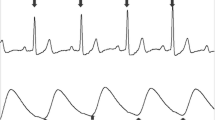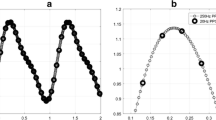Abstract
Heart rate variability (HRV) analysis from 10s ECGs has been shown to be reliable. However, the short examination time warrants a user-friendly system that can be used forad-hoc examinations without normal preparation, unlike ECG. A handheld device has been developed that can measure ultra-short HRV from impedance plethysmographic recordings of the pulse wave in distal superficial arteries. The prototype device was made user-friendly through a compact, pen-like design and the use of integrated metal electrodes that were especially designed for dry operation. The main signal processing was performed by a digital signal processor, where the discrete heart beats were detected using a correlation algorithm that could adapt to individual pulse wave shapes to account for biological variation. The novel device was evaluated in 20 mainly young volunteers, using 10 s time-correlated ECG recordings as the reference method. Agreement between the two methods in measuring heart rate and root mean square of successive differences in the heart beat interval (RMSSD) was analysed using correlation coefficients (Pearson's R2), mean differences with 95% confidence intervals and 95% limits of agreement, and Bland-Altman plots. The correlation between the two methods was R2=1.00 and R2=0.99 when heart rate and RMSSD were measured, respectively. The Bland-Altman plots showed suitable agreement between the novel device and standard 10 s ECGs, which was substantiated by 95% limits of agreement of the difference of ± 0.1 beats min−1 and ∼ ± 10 ms for heart rate and RMSSD, respectively. Therefore the evaluation showed no significant systematic error of the novel device compared with ECG.
Similar content being viewed by others
References
Bikkina, M., Alpert, M. A., Mukerji, R., Mulekar, M., Cheng, B. Y., andMukerji, V. (1998): ‘Diminished short-term heart rate variability predicts inducible ventricular tachycardia’,Chest,113, pp. 312–316
Bland, J. M., andAltman, D. G. (1986): ‘Statistical methods for assessing agreement between two methods of clinical measurement’,Lancet,1, pp. 307–310
Bland, J. M. andAltman, D. G. (1995): ‘Comparing methods of measurement: why plotting difference against standard method is misleading’,Lancet,346, pp. 1085–1087
Brown, B. H., Wilson, A. J., andBertemes-Filho, P. (2000): ‘Biomedical electronics — Bipolar and tetrapolar transfer impedance measurements from volume conductor’,Electron. Lett.,00036, pp. 2060–2062
Concannon, M. J., Stewart, D. H., Welsh, C. F., andPuckett, C. L. (1991): ‘Impedance plethysmography: a new method for continuous muscle perfusion monitoring’,Plast. Reconstr. Surg.,88, pp. 292–298
De Bruyne, M. C., Kors, J. A., Hoes, A. W., Klootwijk, P., Dekker, J. M., Hofman, A., van Bemmel, J. H., andGrobbee, D. E. (1999): ‘Both decreased and increased heart rate variability on the standard 10-second electrocardiogram predict cardiac mortality in the elderly: the Rotterdam Study’,Am. J. Epidemiol.,150, pp. 1282–1288
Hamilton, R. M., Mckechnie, P. S., andMacfarlane, P. W. (2004): ‘Can cardiac vagal tone be estimated from the 10-second ECG?’,Int. J. Cardiol.,95, pp. 109–115
Martinsen, Ø. G., Grimnes, S. andSchwan, H. P. (2002): ‘Interface phenomena and dielectric properties of biological tissue’,Encyclop. Surface Colloid Sci., pp. 2643–2652
McNames, J., Thong, T., andGoldstein, B. (2003): ‘Reliability and accuracy of heart rate variability metrics versus ECG segment duration’ (IEEE Inc., Cancun, Mexico, 2003), pp. 212–215
Migliaro, E. R., andContreras, P. (2003): ‘Heart rate variability: short-term studies are as useful as holter to differentiate diabetic patients from healthy subjects’,Ann. Noninvas. Electrocardiol.,8, pp. 313–320
Molgaard, H., Sorensen, K. E., andBjerregaard, P. (1991): ‘Attenuated 24-h heart rate variability in apparently healthy subjects, subsequently suffering sudden cardiac death’,Clin. Auton. Res.,1, pp. 233–237
Nyboer, J. (1960): ‘Regional pulse volume and perfusion flow measurement. Electrical impedance plethysmography’,Arch. Intern. Med.,105, pp. 264–276
Porter, J. M., andSwain, I. D. (1987): ‘Measurement of cardiac output by electrical impedance plethysmography’,J. Biomed. Eng.,9, pp. 222–231
Schroeder, E. B., Whitsel, E. A., Evans, G. W., Prineas, R. J., Chambless, L. E., andHeiss, G. (2004): ‘Repeatability of heart rate variability measures’,J. Electrocardiol.,37, pp. 163–172
Seo, A., Rys, M., andKonz, S. (2001): ‘Measuring lower leg swelling: optimum frequency for impedance method’,Med. Biol. Eng. Comput.,39, pp. 185–189
Swanson, D. K., andWebster, J. G. (1983): ‘Errors in fourelectrode impedance plethysmography’,Med. Biol. Eng. Comput.,21, pp. 674–680
Task Force European Society of Cardiology and North American Society of Pacing and Electrophysiology (1996): ‘Heart rate variability. Standards of measurement, physiological interpretation, and clinical use’,Eur. Heart J.,17, pp. 354–381
Thong, T., Li, K., McNames, J., Aboy, M., andGoldstein, B. (2003): ‘Accuracy of ultra-short heart rate variability measures’ (IEEE Inc., Cancun, Mexico, 2003), pp. 2424–2427
Tsuji, H., Larson, M. G.,Venditti, F. J., Jr., Manders, E. S., Evans, J. C.,Feldman, C. L., andLevy, D. (1996): ‘Impact of reduced heart rate variability on risk for cardiac events. The Framingham Heart Study’,Circulation,94, pp. 2850–2855
Yamamoto, Y., Yamamoto, T. andOberg, P. A. (1991): ‘Impedance plethysmography in human limbs. Part 1. On electrodes and electrode geometry’,Med. Biol. Eng. Comput.,29, pp. 419–424
Author information
Authors and Affiliations
Rights and permissions
About this article
Cite this article
Kristiansen, N.K., Fleischer, J., Jensen, M.S. et al. Design and evaluation of a handheld impedance plethysmograph for measuring heart rate variability. Med. Biol. Eng. Comput. 43, 516–521 (2005). https://doi.org/10.1007/BF02344734
Received:
Accepted:
Issue Date:
DOI: https://doi.org/10.1007/BF02344734




